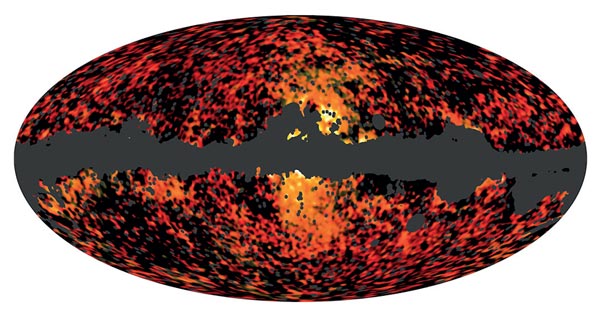
Image credit: ESA/Planck collaboration.
While awaiting the Planck mission results on the Cosmic Microwave Background (CMB), the scientific community must be content with measurements on foreground sources. Those are nevertheless providing interesting and unexpected results, especially by mapping a mysterious haze in the central portion of the Milky Way, and by producing the first all-sky map of molecular clouds where stars are born.
It was a risky strategy for the European Space Agency to launch two prime missions of its scientific programme on 14 May 2009, Herschel and Planck (CERN Courier July/August 2009 p6), but the Ariane 5 rocket succeeded in sending both spacecraft into orbit around the second Lagrange point of the Sun–Earth system. Both missions use this prime location – 1.5 million kilometres away – to study the cold universe unaltered by the glow of the Earth and Moon. However, they each operate differently. Herschel is an observatory, in the sense that any astronomer can propose an observation of a source of interest and get data rights if their proposal is accepted. This approach does not apply to Planck – which is continuously scanning the sky, so the data have to be shared among the Planck collaboration as a whole.
The Planck data acquisition is slowly nearing completion. The spacecraft had enough helium-3 to cool down the high-frequency instrument (HFI) to 0.1 K for 30 months, about twice what was originally required. Since January, however, only the low-frequency instrument (LFI) continues to operate, mainly to refine the calibration. The data release of the nominal mission (the first 15.5 months) is planned for early 2013; the full data set will become public a year later. Both releases will be accompanied by scientific publications on the observed fluctuations of the CMB, which are the most anticipated by the scientific community. The Planck results will improve the determinations of the constituents, the history and the fate of the universe obtained by NASA’s Wilkinson Microwave Anisotropy Probe (CERN Courier May 2008 p8).
The Planck CMB results have not yet been published because many Galactic and extra-Galactic foreground sources superimpose on the CMB, as illustrated by the all-sky image released in the summer of 2010 (CERN Courier September 2010 p11). Disentangling the various components from each other is a tricky task that requires a deep understanding of all foreground sources and instrumental effects. While some Planck scientists work on the CMB, others work on the removal and characterization of these foregrounds. A first set of early Planck results was released in January 2011, together with a catalogue of thousands of compact sources both in the Milky Way and in distant galaxies and clusters of galaxies. The next set of Planck results on foregrounds was presented at an international conference on 13–17 February 2012, in Bologna, and will be published in the coming months. This includes two unexpected results on the diffuse emission of the Galaxy.
One surprise came from the detailed, all-sky map of carbon monoxide (CO) presented by Jonathan Aumont of the Institut d’Astrophysique Spatiale, Université Paris XI, Orsay. The CO molecule emits a number of narrow, rotational emission lines in the frequency range probed by Planck’s HFI. The spectroscopic measurement of these lines is commonly used to probe the presence of cold molecular clouds from which new stars form. Because the CO lines are narrow compared with the broad spectral bands observed by Planck, it was not anticipated that it would be possible to measure their contribution and thus compete with spectroscopic surveys of CO.
Another unexpected result was presented by Krzysztof Gorski of the Jet Propulsion Laboratory, Caltech, Pasadena, and Warsaw University Observatory. He presented a map of the sky showing a distinct synchrotron emission that is roughly co-spacial with the giant gamma-ray bubbles detected by the Fermi Space Telescope (CERN Courier January/February 2011 p11). This suggests that the radio and gamma-ray emissions could come from the same population of relativistic electrons filling the bubbles – but their actual origin remains mysterious.







